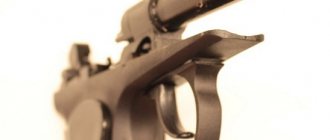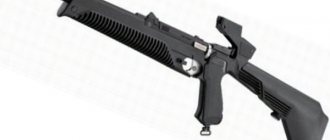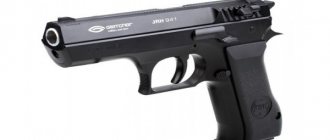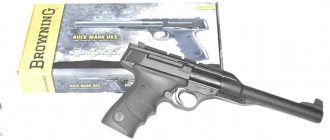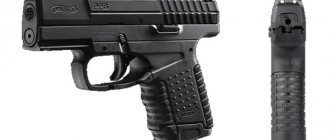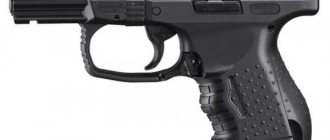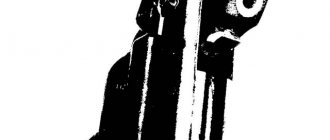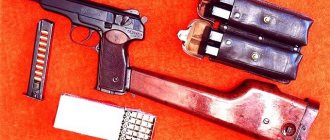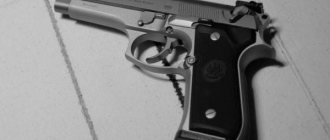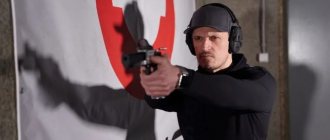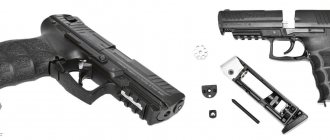Choosing a model of an air pistol up to 3 J or an air rifle up to 7.5 J often comes down to the choice between a weapon for recreational shooting that shoots 4.5 mm bullets with a recognizable shape and the same weapon that shoots 4.5 mm balls.
Bullets: time-tested design
There is an opinion that a “pneumatic gun” that shoots 4.5 mm bullets is better suited for targeted shooting. It is believed that the bullets:
- they fly more accurately than balls;
- better maintain trajectory (you can fire an aimed shot at a greater distance);
- have less energy (less likely to cause injury if accidentally hit).
And all this is true to one degree or another. But it only applies to lead bullets with a rounded head. The same ones that could be found in Soviet shooting ranges. Now they are also being produced - these are the cheapest and simplest bullets. Which can be used to shoot at targets with a bullet catcher indoors.
But, for example, bullets with a steel core and a conical head have much more energy. Such bullets “break bottles” or “pierce through tin cans” are better than steel balls.
Since the cost of 4.5 mm bullets for “pneumatics” up to 7.5 J is relatively low, it is better to give preference not to rolled but stamped bullets (that is, to also take into account the manufacturing method).
Shape and size of pneumatic bullets, their characteristics
The bullet head can be not only rounded or conical. It may have a hole (as in combat expansion bullets). Or with a hole and a “needle” head. Such bullets are used for hunting rodents.
In addition, bullets can have a flat head (suitable for precision target shooting). And also not have a recognizable conical shape, but be straight (with different heads).
Also, bullets can have different weights and lengths. All these bullets differ from each other in terms of energy, shooting accuracy, firing distance, and cost.
Bullets 5.5 mm and 6.35 mm were originally created for hunting. Therefore, their characteristics are fully manifested only when fired from a hunting air rifle up to 25 J, sold only under license. Therefore, comparing them with balls makes no sense.
Balls for recreational shooting
Balls are fired only from “pneumatic guns”, which do not require a weapons permit. There are a number of air rifles (and even machine guns abroad) up to 25 J that shoot balls, but these are exotic.
The main advantage of the balls is their shape. In general, it doesn’t matter which side they hit the barrel. This means they can be used to equip clips not only for 10-30, but also for 200-300 balls. They can be fired in bursts (if the design of the weapon allows), which is more interesting.
The balls come in “fast” steel balls (easily breaking a bottle from 10 meters) and “slower” lead balls.
Which rifle to choose for bullets and balls
A significant part of modern copies of military weapons are smooth-bore “balloons”. This allows you to better simulate firing from a military weapon. Repeating semi-automatic rifles that fire pellets are also found, but are equipped with a drum magazine.
That is, if you need, for example, a good pneumatic copy of a Colt 1911 or a “bunker” rifle for a large number of shots, then the balls have the advantage. But if it’s an accurate multi-compression air pistol, an externally pumped rifle, or the good old “breaker,” then it’s better to lean toward pellets.
If you want “more powerful”, then it is better to choose bullets with a conical or “expansive” head and a steel core.
Disassembly and cleaning
Any gun loves affection, cleanliness and lubrication. So we strongly recommend that fans of pneumatic guns also read the section on how to properly disassemble and clean weapons. Such a procedure should be carried out at certain intervals (ideally, after each use of the gun). Only in this case will it be possible to increase the service life of your favorite pneumatics, as well as improve its technical characteristics:
Step 1 - we carry out partial disassembly of the pistol
To do this, first remove the magazine with cartridges, and also make sure that there is no bullet left in the barrel (pull back the bolt). Afterwards, we set the weapon on the safety and pull back the bolt frame, after pressing the trigger guard. After this, removing the receiver will not be a problem - you just need to pull it back and up.
Step 2 - clean the barrel
To get rid of soot and lead deposits formed during the shooting process, you will need to use special brushes made from different materials. For example, plastic removes light deposits, copper removes leaded deposits, and a steel brush is best used only if you have to get rid of tough contaminants, because it scratches the rifled barrel.
Step 3 - wash the barrel and lubricate it with oil
After cleaning the carbon deposits, you will have to thoroughly rinse the barrel with soapy water. If you feel that there are remnants of old oil inside, you can use kerosene to degrease. However, be sure to remove all chemicals with soapy water after this and dry the gun thoroughly. Only after this can a new lubricant be applied using a rag and cleaning rod.
When lubricating a gun or carrying out a carbon cleaning procedure, it is important to remember the golden rule of moderation. If you work too hard with a brush, this will certainly lead to scratches on the rifled barrel.
If you apply too much lubricant, a lot of smoke will come out of the barrel (it’s beautiful, but it’s quite harmful to the “health” of the weapon), so don’t overdo it.
Stalker pistol models
A person who decides to give preference to a Chinese company will be pleasantly impressed by the wide assortment of the arms company. Regardless of what kind of weapon you like, you can be 99% sure that a similar model will be found in Stalker’s warehouse. Here are just a few popular models, as well as their brief descriptions:
- Stalker S92ME (2850 rubles). A classic air pistol for training and recreational shooting based on the famous Beretta. The pistol is equipped with the ability to adjust the softness of the trigger, as well as a modern rear sight and front sight, on which fiber-optic threads are applied.
- Stalker S1911G (2000 rubles). From the name it is clear that the famous Colt 1911, which is very popular in the United States, served as a prototype for the development of this model. The pistol is perfect for airsoft, since its muzzle energy is only 2 J.
- Stalker SPM (2500 rubles). An almost exact copy of the Russian Makarov pistol, a legendary pistol used by government agencies. Of course, the weapon is in many ways inferior to the same Baikal MP-564K-32, but the difference of 7 thousand rubles says: “Think again, don’t overpay!”
- Staler STT (3000 rubles). Another model, the prototype for which was the Soviet Tokorev pistol. A distinctive feature of the STT is its full automatic operation, making the pistol suitable for use in tactical war games even as a primary weapon.
- Stalker S17G (3200 rubles). And here is the famous NATO aircraft, which is in service in most European countries. The weapon is very popular among connoisseurs, so I simply could not help but release this model as one of the first. Suitable for shooting at targets or bottles.
And all this is just a small part of what can be found on the manufacturer’s official website. Despite the fact that the company is quite young, it has already been able to satisfy the desires of millions of customers. Pneumatics are especially popular in Russia because they have a low price - not all citizens of our country have the opportunity to pay twice as much for imported brands, so Stalker offers a good alternative.
Design and diagram of an air pistol
Let us immediately note that if up to this point you have never read articles about pneumatic devices, then it will be quite difficult for you to understand exactly what actions should be taken, because all the information is diluted with a rather large number of unfamiliar terms for beginners. However, do not rush to close the tab, because in this section you will find a detailed diagram with a description of each detail using the example of the Baikal MP-654K pistol (Makarov air pistol).
So, first, let’s find out what the main elements of such weapons are and what function they perform. Let's start with the most important things that everyone should know and end with those that perform secondary functions or also serve to absorb momentum when shooting:
- USM or trigger mechanism. In a Makarov air pistol, it consists of a trigger, a trigger box, an exhaust valve and a gas cartridge, which is the main source of energy. Several springs are used to cock the trigger, and screws and pins are used to secure the parts. The trigger is the most complex part of the gun, so complete assembly and disassembly should only be done by a professional.
- Barrel and receiver with one bolt. With a slight movement of the hand, the owner of the MP-654K pistol can feed a cartridge from the magazine into the receiver, thus loading the pistol. When fired, the bullet will pass through a steel barrel that has a large number of grooves. These grooves are used to twist the ballistic bullet and have higher accuracy. A receiver is used to protect the barrel.
- Pistol grip and magazine. The part that the shooter holds when aiming and shooting is called the handle. It can come in different types and shapes, but in most cases it is designed for right-handed shooting. As for the magazine, this part is intended for storing cartridges. The Makarov tire holds 13 pieces (+1 cartridge can be immediately sent into the barrel).
And these are just the main parts and mechanisms that play an important role during loading and shooting. Also, do not forget about smaller systems, for example, an automatic safety, a sight (rear sight + rear sight) and various compensators with shock absorbers that absorb recoil at the moment of firing. However, a novice shooter does not need to know them, so let's first try to figure out what they are.
We provide ourselves with comfort and safety
General rules: charge only in water, not on land. And before starting this operation, try to hold your breath, inhaling deeply. Otherwise, you can get carried away, breathe actively, and begin to “drown”.
Now about the crossbow. You only need to charge it while wearing gloves! Otherwise, all your fingers will be torn off. Or even worse, something will happen - after all, most of the bridles that hold the rods are made of plastic, which can collapse over time. And if the bridle falls apart, then the fingers will be in trouble.
And one more thing: if you hunt with a crossbow without a wetsuit, you can end up with bruises all over your chest. Therefore, you need to put something soft under it. For this purpose, special stops are sold, which are very convenient. By the way, there are some that are attached to a weight belt.
And to protect your fingers when charging a pneumatic gun, it would be a good idea to use safe metal T-shaped chargers - they are very inexpensive. Some craftsmen, by the way, make them themselves - you can find a description on the Internet. With such loaders, your hands remain intact, and the harpoon is guaranteed not to fall off (if the piston is not clearly fixed).
Preparing the gun for use
If you think that an air gun can be used immediately after purchasing it in a store, you are deeply mistaken. Most manufacturers soak weapons in a special preservative lubricant, which increases shelf life, but cannot be used for shooting (combat accuracy will be too low and carbon deposits will begin to form much faster). Therefore, after purchase, it is recommended to first carry out the depreservation procedure:
- We carry out partial disassembly of the weapon (according to the same scheme as in the case of cleaning and lubrication).
- Remove all preservative liquid by tightening with a stick or rag.
- We thoroughly degrease not only the barrel, but also all metal parts.
- We wash the barrel with soapy water (water + any detergent).
- We apply new oil to the barrel, for example the popular Balistol spray.
- To lubricate small parts (for example, USM), we use a special silicone liquid).
- We assemble the weapon, carefully placing all the parts in place.
After this, you will also need to check how well the gun shoots. Unfortunately, many gun store salespeople deliberately override the factory settings so that customers will contact them for help. However, adjusting the front and rear sights does not require much knowledge and experience. Just follow some instructions and recommendations from professionals:
- We find a suitable place for shooting. It is better, of course, to give preference to the shooting range, since there neither wind nor humidity will affect the bullet. However, if traveling to such an establishment is not possible, wait for a clear, windless day, then go outside the city into a forest or open field where there are no people.
- Prepare yourself for a comfortable position. To reset the gun as efficiently as possible, it is best to use a special automatic locking device. However, not everyone has such a device. Alternatively, a sandbag shaped to fit the gun is a good choice.
- We take several test shots from a distance of 5 meters. The best place to aim is the bottom of the black circle on the target. It is important that everyone shoots in the same place to see how wide the gun is. If the combat accuracy is good, the aiming position is convenient.
- After taking a few test shots, you can begin to adjust the position of the viewfinder using the two swirls on the back panel (adjust the vertical and horizontal positions). After that, we’ll take a few more pictures and see how the result has changed.
Also, when zeroing, try not to run around, adjusting only one position per phase (vertical or horizontal), otherwise it’s easy to get confused in your own calculations. It is also worth gradually increasing the distance to the target, otherwise the spread may be too large with a subsequent increase in the distance.
Precautionary measures
To prevent tire shooting from leading to unfortunate situations, it is strongly recommended to follow basic safety rules that will protect not only the shooter, but also those around him:
- treat any weapon as if it were loaded - you should not play with a shotgun;
- loading an air gun is only permitted if there is no one in the firing line;
- if the shot does not occur when you press the trigger, you should be extremely careful;
- for short-range shooting it is worth using personal protective equipment;
- before reaching the aiming target, you should turn the barrel to the side;
- if rustling or voices are heard, you should put the gun aside;
- Before shooting from above, you need to make sure its barrel is clean.
Remington 700 ADL Air Rifle Zeroing an air rifle is a process that is not difficult even for a novice hunter. If you have difficulties adjusting the optics or rear sight, or you cannot find a suitable place outside the city, do not neglect the opportunity to go to the nearest shooting range, where specially trained people will help you not only in words, but also in deeds.
Punishment
The law clearly states whether an air pistol can be freely carried, how and under what conditions. But what is the punishment for those who break the rules?
Consequently, violation of the rules for handling pneumatic weapons may entail fines from 500 to 2 thousand rubles or deprivation of the opportunity to purchase, store, and use weapons for a period of 6 months to a year.
How to properly load an air pistol
So now that you know the basics, it's time to talk about how to properly load an airgun. But first of all, we advise you to carefully read the safety rules, otherwise even the slightest mistake can lead to dire consequences. Unfortunately, pneumatic guns can also kill their owner if they hit a vulnerable spot.
Security measures
Safety rules are a topic that the authors of most articles tend to forget about. However, this information will be relevant not only for beginners, but also for professional shooters, because the basics are often forgotten even by masters, which leads to dire consequences:
- Always handle the gun as if it might fire at any moment. Even if you know for sure there are no bullets in the magazine, follow this rule to develop the habit of being careful. If you neglect this rule, then sooner or later an accidental shot will occur, and God forbid anyone gets hurt from this.
- Keep it safe anytime, anywhere and only shoot if you are ready to fire in seconds. Even in Hollywood action movies, a villain or cop may hold a person at gunpoint for a few seconds, negotiate and, just before shooting, remove the gun from its safety lock. This precaution will not be superfluous.
- Don't touch the trigger if you don't want to shoot. It's also not a good idea to check to see if the safety is on or if it can be loaded with a "light trigger pull." Such actions often lead to tragic consequences, so remember that the trigger is intended for only one purpose - to fire.
- Never hand a loaded pistol into the hands of persons unfamiliar with safety precautions. Remember that a weapon is not a toy, including pneumatics. Therefore, do not allow children or other relatives to play with the gun, especially if it contains ammunition.
Before disassembling the gun (if it is necessary to repair or replace the gas cylinder), make sure that the device is completely empty and locked. If this is not done, the likelihood of getting shot in the arm or other part of the body is extremely high.
And these are just the basic safety rules that must be strictly followed. Of course, there are many other points regarding storing or using a pistol when shooting at targets, but we will not touch on them, since they do not fit into the main topic of the article - pneumatic reloading.
Installing and removing the CO2 cylinder
Now that you have become familiar with the basic safety rules, you can move on to the actual procedure of loading a weapon. It begins not with placing cartridges in the magazine or even with releasing the shutter, but with installing a gas cylinder, since without a power source the shot simply will not happen. In addition, a can of compressed air tends to come out gradually, so this information will be very relevant:
Step 1
We follow basic safety rules.
Before working with a gas cylinder, it is important to make sure that the pistol is completely unloaded, the magazine with cartridges is disconnected, and the trigger is on the safety. Only in this case can the action be removed by pressing the jumper and removing the return spring. The small reservoir at the back of the barrel is called the gas cylinder.
Step 2
We remove the old gas cylinder.
To do this, you must first unscrew the cap and also remove the two pipes supplying compressed air to the cylinder. After this, you can manually unscrew the tank itself (tools are only needed if you need to remove the entire trigger). For those guns whose tank is located near the magazine, the disassembly process is sometimes easier (detailed instructions in the video).
Step 3
We install a new cylinder.
After removing the old gas cylinder, you can screw in the new complete power supply. To do this, open the package and place the container so that the tubes are in front and the holder is in the back. We twist the balloon as long as the metal wire allows. It is not necessary to fix it too tightly, as this may complicate the removal process.
Some Chinese models of gas cylinders can explode at temperatures above 50 degrees Celsius. So don't replace it in the hot sun or place the new tank on hot iron or asphalt. It is best to do this at home, on the table, where there is nothing superfluous. As for storing a new gas cylinder, it is best to do this in a dark place inaccessible to other people.
Loading and removing bullets
The second stage of loading is to place the bullets in the magazine and direct the ballistic bullet into the barrel. However, many new shooters also ask us how to properly remove a bullet that is already in the receiver or magazine. Some even go to the extreme of firing all the ammunition they have. Such actions can hardly be called cheap, especially if there are instructions for loading and removing bullets:
Step 1 - Load the Magazine
First you need to disconnect the empty tank from the gun and prepare the bullets for loading by removing them from the box. It's best to count 13 at a time to avoid wasting extra ammo or trying to put more ammo into the 14 gun than it can hold. This procedure is extremely simple and requires only one thing: convenient placement of steel balls in a small round magazine opening.
Step 2 - Loading the Barrel
Once the magazine is loaded, you can insert it into the gun for further action. To send a bullet into the receiver, simply pull the bolt holder back. After this, the trigger will be cocked, the safety will be automatically set, and one of the bullets from the magazine will enter the barrel, after which the pistol can be removed from the safety and fired.
Step 3 - removing the bullet from the barrel and magazine
If you have already fully loaded the gun, but no longer need to shoot, you can remove the existing cartridges. However, it is important to note that this is not a chargeback. That is, you first need to remove the magazine, and only then push back the bolt holder, from which the cartridge will fall out. Also remember to fire blanks to fully discharge the gun.
As you can see, the upload and download process is also simple. The most important thing is to strictly follow the instructions described, and also not to neglect safety rules. This is especially true for the unloading procedure, since it is during this that most accidents occur due to the fact that the owner of the pistol simply forgets that not only the magazine, but also the barrel of the weapon is loaded.
Final Recommendations
At this point, the store renovation can be considered complete. A few more tips: change the seals (preferably at least two - one above the cylinder and one for the valve) every two or three cylinders. Do not use 8 gram cans: they will crap on the seals and valve! Eight grams kills, first of all, the cylinder seal through the use of an adapter: it cuts it with its thin and narrow edges; then the gasket on the valve quickly turns yellow and loses its elasticity, which leads to leaks when filling an imported cylinder (apparently it cannot withstand higher pressure). Well, lead shavings, of course, fly out of the cylinder. The filter (if you left it, of course, during the update) also does not help. Try not to keep the tank full for long, otherwise the next tank will deflate in an instant. No, it can, of course, but the probability is high. That's all, perhaps, for repairs.
Completeness
| Name | Quantity | Position (see Fig. 2) |
| Gun | 1 | |
| Adapter | 1 | |
| Ring 10.5x1.4 | 1 | 5 |
| O-ring 6x2 | 1 | 12 |
| Ring 6.7x1.9 | 2 | 14 |
| Valve ring 7.3x1.8 | 1 | 7 |
| Sealing element | 1 | 11 |
| O-ring 9x2 | 1 | 15 |
| Screwdriver | 1 | |
| Passport | 1 | |
| Package | 1 | |
| List of addresses of workshops for repairing sporting and hunting weapons | 1 |
How to properly insert a cylinder into an air gun
Model Walther PPK/S
Caliber 4.5 mm (.177)
1. Insert the fuse.
A. To engage the safety, release the trigger, move the safety lever to the down position S, covering the red indicator, see Fig. 1.
B. When handling a pistol, it must be secure and the muzzle must be pointed in a safe place.
C. To remove the safety lock, slide the safety lever to the horizontal position to reveal the red indicator.
2. Load the gun with gas cylinders and unload it
2.1 How to insert a gas cylinder
Note: Use only 12g carbon dioxide canisters! Do not use cylinders containing other gases!
Fold the left cover. (Illustration 2.) Insert the can with the wide side down (Illustration 3), then immerse it completely in the handle and tighten the screw until it punctures. The container is now perforated and sealed. Put the tampon back in place.
To make sure the can is broken, shoot in a safe direction after making sure the gun is not loaded. If the gun does not fire, repeat the loading procedure.
2.2 How to remove the gas cylinder
Release the trigger, engage the safety, and point the gun to a safe location. Remove the cover and unscrew the screw. Remove the used bottle.
3. How to load and unload a gun
A. Remove the magazine by pressing the release button (on the left above the jumper).
B. With the ball pusher down (Figure 4), load 15 balls into the magazine.
C. Install the magazine into the gun.
4. Shooting safety
A. Make sure the gun is secure, insert the gas cylinder and charge the gun as described above.
B. Release the safety when you are ready to fire.
C. To fire the first shot, you must manually cock the hammer or tighten the bolt.
D. The pistol is ready to fire. Point the barrel at the target and pull the trigger.
E. After the first shot, the bolt carrier is automatically reversed to prepare the pistol for the next shot.
5. Use and storage of a gas cylinder
Improper storage or firing too quickly can adversely affect the performance of the gas cylinder.
1 quick shot reduces the pressure in the can and, as a result, the speed of the projectile
2 Rapid response reduces efficiency
Loading with bullets
For air pistols, .177 caliber ammunition is used, the diameter of which does not exceed 6.5 mm. You cannot shoot non-standard bullets; it can be dangerous or damage the weapon. Also, bullets should not be reused.
Bullet loading process:
- Put the gun on safety (point the muzzle in a safe direction).
- Press the button to remove the magazine.
- Lower the filler and place the required number of bullets (indicated in the instructions).
- Put the store in place.
More detailed instructions can be found in the user manual that comes with the pneumatic.
Sometimes you may need to unload a pistol without firing shots; to do this, you should adhere to the following algorithm:
- Put the fuse on.
- Remove the gas container.
- Open the shutter.
- Insert a cleaning rod of suitable diameter.
- Push the ball into the bullet receptacle.
It is not always the case that ammunition does not come out of the muzzle that means the magazine is empty. This may be due to insufficient gas pressure, causing the bullet to get stuck. Before taking the next shot, you need to remove the stuck ball.
Disassembly and cleaning
Any gun loves affection, cleanliness and lubrication. Therefore, we strongly recommend that airgun enthusiasts also read the section on how to properly disassemble and clean your gun. This procedure should be performed at regular intervals (ideally after each use of the gun). Only in this case will it be possible to increase the service life of your favorite pneumatics and improve its technical characteristics:
Step 1 - we carry out partial disassembly of the pistol
To do this, first remove the magazine with cartridges, and also make sure that there are no bullets left in the barrel (pull the bolt back). After: put the pistol on the safety and remove the bolt frame by pressing the jumper. After this, removing the receiver will not be difficult - you just need to pull it back and up.
Step 2 - clean the barrel
To remove carbon deposits and lead formed during the shooting process, you will need to use special brushes made of different materials. For example, plastic removes light carbon deposits, copper removes lead deposits, and a steel brush is best used only if you need to remove stubborn dirt as it will scratch the rifled barrel.
Step 3 - wash the barrel and lubricate it with oil
After cleaning the carbon deposits, you must thoroughly rinse the barrel with soapy water. If it seems to you that there are remnants of old oil inside, you can degrease it with kerosene. However, be sure to clean off any chemicals with soapy water afterwards and dry the gun thoroughly. Only then can new lubricant be applied using a rag and a cleaning stick.
When lubricating your gun or carrying out the charcoal cleaning procedure, it is important to remember the golden rule of moderation. If you brush too hard, it will certainly cause scratches on the rifled barrel.
If you apply too much lube, a lot of smoke will come out of the barrel (nice, but practically bad for the health of the gun), so don't overdo it.
How to properly load a crossbow
Carefully insert and secure the harpoon well. Then don’t forget to put the device on the fuse. Now we lay the straightened line of the harpoon along the ejector and straighten the rubber rods, at the same time looking out in which direction to point the weapon so as not to accidentally hit people.
The next operation must be done while lying on the water (under no circumstances standing). And a crossbow for underwater hunting should also be in a horizontal position. One hand rests on the pull rod to the place where the bridle is attached. The palm of the second hand rests on the buttplate of the crossbow (if there is one) or on its handle.
We press with our palm, pulling the elastic band about a third, until the gun is very close, and then we change its position (perpendicular to our own body). We rest the butt plate against the chest (a pad is usually placed on the wetsuit in this place for ease of loading).
The final part is the most difficult. We tighten the elastic band so that we can take it with both hands, and then we pull it strongly and throw it over the hook on the harpoon. If everything is done normally, you can release your hands, moving them first forward, then in different directions. It is not difficult to tighten the remaining rods.
MP-651K – versatility and power in one gun
MP-651K is a Russian air pistol, in demand on the arms market since 1996. If you are still in doubt about which air gun to choose, take a look at this product.
Its main difference from pistols of other brands can be considered to be the transformation into a rifle or light carbine when using the entire configuration. This gun belongs to the cylinder type of pneumatic weapon, and a 12-gram cylinder of carbon dioxide is enough for 70 shots.
This weapon uses 4.5 mm lead or steel bullets. Such spherical projectiles develop a speed of 114 m/s if the gas cylinder is completely filled, and up to 104 m/s when there is no longer enough gas. Despite its impressive appearance, the pistol weighs only 0.7 kg, and in the carbine version - 1.5 kg.
Types of gas for refilling
There are several main types of gas pistols, distinguished depending on the type of substance for refueling: green gas, red gas, black gas, CO2.
Airsoft weapons are most often loaded with two options:
- Green gas - propane or its compound with methane. The substance has a high degree of purification. The composition sometimes includes flavorings and lubricants. The physical state of green gas is liquid.
- Carbon dioxide (CO2), which is supplied in cylinders with a capacity of 7 to 88 grams. The standard size is 12. The physical state of the substance is liquid, but during the use of the gun it changes to gaseous.
Other types of refills are used less frequently, although they are capable of providing a significant range of shots. Red and black gas put a lot of wear and tear on the gun. The use of substances of this type requires an individual upgrade of weapons, maximum tuning. The basic configuration most often does not include red and black gas refueling.
What you need to know when choosing an air gun
After seeing crime news and news on TV, as well as learning what is happening in their neighborhood or city, more and more people want to buy some kind of self-defense equipment. The choice of many people who want to protect their lives is an air rifle.
And it has become quite ingrained. First, most models can be purchased without permission. Secondly, they have a fairly low price and an outwardly normal person would not even be able to distinguish a tire from a real gun. But everyone who wants to buy pneumatic guns will have a question: “How to choose the right air gun?”
Guns for: roofing, framing, flooring, finishing with pins or staples.
There are four main applications for nail guns:
- roofing guns for soft tiles,
- frame nailers for driving large nails into thick material,
- parquet guns for working with flooring,
- finishing models, light and convenient pins for careful work on furniture, interiors, moldings and pins and staples for delicate work.
It is important to look at the description of the gun before purchasing, since there are different specific features in the work - some finishing guns can be used as light nailers, while others cannot.
Air pistol MP-651K Cornet - hardball review
I bring to your attention a review of the cheapest hardball gun: MP-651K “Cornet” (there is a KS version), nicknamed “Castratus” in Tyndinsky’s team.”
Equipment
The delivery set includes: the Baikal MP-651x air pistol itself, a drum magazine attached to a cable for firing rifle cartridges, and a registration certificate. All of this is in terrible packaging (almost wrapped in newspaper).
Owner's view
The body of the pistol is made of fairly durable plastic. Previously, “cornets” were produced in a metal case (IZH 671) and under a 6 gram CO2 cylinder and a non-removable drum. No other design differences were noticed.
The current IZH-651 Kornet air pistol is loaded with a 12-gram cylinder and has an above-barrel magazine for 23 spherical 4.5 mm bullets, which are delivered into the barrel through a drum magazine before firing. The weapon kit includes a second drum magazine for firing rifle cartridges, with a capacity of 8 places. When installing this magazine, it is not recommended to shoot spherical bullets. In practice, in hardball these magazines are not used by fighters; shooting is carried out with spherical bullets (babes).
The gun has a relatively long barrel and can hit a target 15 meters tall, so it depends on the training of the shooter. The viewfinder is adjustable in two planes.
A special feature of the design is the aforementioned magazine above the barrel. The main advantage of such a store is the content of information. The fighter always has before his eyes the number of cartridges in the magazine. It is not necessary, as usual, to take the store out to look and then enter it again. However, this is also a big drawback, because all the dirt, sand and other elements undesirable for weapons are there. The process of equipping the magazine is also very convenient: we take the gun by the barrel, tighten the feed spring with our finger and fill the cartridges into the open window.
But with a balloon it’s not so simple. To replace the cylinder, you must remove the handle. At the same time, the bolt that secures it is very inconvenient to unscrew while wearing gloves. True, the Cornet also uses gas very economically. Fighters usually take a spray can with them, and this is almost always enough.
The Kornet air pistol is equipped with a special safety lock. This is a button mounted directly on the trigger. When pressed, it sharply blocks the trigger. Fully functional system. The Cornet has no other controls, except perhaps the drum magazine release button. The pistol has two firing modes: self-cocking and pre-cocking, and, unlike all pistols, its trigger resembles a key, which is recessed into the body when cocked.
The Cornet has no prototype in the world of firearms; it was created exclusively as an air pistol.
Pistol performance characteristics
Magazine capacity: 8 rounds, 23 balls
Barrel length 148 mm.
Muzzle energy no more than 7.5 J
The initial projectile speed is 120 m/s.
Dimensions 260x200x35 mm.
In conclusion, I would like to add that the Cornet, being an inexpensive pistol (its price ranges from 2500 to 3000 rubles, can be found on the Internet for 1950 rubles), is quite suitable for hardball, especially for a beginner. It's worth your money. A fighter armed with two horns (two hands) can also compete with a blackbird (albeit not for long).
Air pistol MP-651KS
Traditionally, Baikal weapons are produced in two modifications - K and KS. The main difference is that the muzzle energy of the KS models is reduced to 3 J, due to the quirks of the gun law. Comparative characteristics of the models:
The KS model has the appropriate markings on board, otherwise there are no significant differences.
Factory modifications
By the way, the cornet is available in a modification with a fore-end, a false barrel and a plastic butt. This body kit makes it look like a futuristic shotgun, but these body kits don't affect the performance, just the price. I haven't seen them for sale separately.
MP-651K with pads
And there is an option for a factory body kit for a machine gun:
MP-651K-23 – sports version
The MP-651k of domestic models is already represented by many modifications, so the plant has released a version for sports shooting based on it. It is clear that the pistol is sharpened according to all modern shooting rules and can be used in any competition. It's not the best option, but the manufacturer still segments it for entry-level competition and training in the use of a sporting pistol.
The full adjustment of the trigger has been changed: it is now possible to adjust the travel of the hook and the force of the trigger. The viewfinder has added micrometric adjustment on two axes. The pistol has become single-shot, but still uses CO 2 as its energy source. The kit also includes a reusable 12 g container and a refilling device.
Makarov 654 K - history of model development
From 1997 to 1999 , the Izhevsk Mechanical Plant produced the MP 654 K with a wide handle and black linings. The pneumatic PM was a copy of the IZH-71-100. Unlike modern analogues, it had many shortcomings that had to be eliminated after operation. One of the main disadvantages was the low quality of the valve.
In 1999 , production of the MP-654K-02 began in Russia with improved technical characteristics and corrected shortcomings. A gift modification of the pneumatic gun has appeared, complete with a carrying case. Patterns and engraving are applied to steel weapons. During production, the customer’s wishes were taken into account; gold, precious metals and stones could be used to cover the metal. Take into account the fact that the more expensive the materials were used, the higher the price of the weapon became.
From 1999 to 2010 , MP-654-K-03 began to fall into the hands of consumers. A classic version that has not changed for more than 10 years. Manufacturers restrained themselves; the only changes were made to the bolt and the slot for the cartridge ejector simulator. Pneumatic pistols with beards and beards with a bevel appeared; PMs with and without a slot for the extractor went on sale.
Until 2010 , the MP-654-K-11 was produced with a camouflage coating and a wide handle without a star.
Until 2010 , the production of MP-654K-15 was carried out, the delivery package of which included false silencers. They had a wide plastic handle and a clamping screw with a swivel.
From 2011 to the present time, MP-654-K-23 with camouflage coating has been on sale. Unlike the 11 series, it is equipped with a hidden clamping screw and has a modernized plastic handle with a star.
Since 2011 , in series 15, the handle was modernized and serial production of the MP-654K-22 began.
Around the same time, the pneumatic PM MP-654K with a nickel-plated coating was produced; it is classified as MP-654K-02. It was modernized and equipped with a narrow handle with a star, a hidden priming screw. Since 2011, the improved PM has been called MP-654-K-24.
The 654K in two-tone design deserves some of the attention. The cost of exotic modifications is higher, which many associate with the higher quality of parts used in the production of pneumatics. Seeing this miracle is very rare these days.
Production of both continues to this day.
Baikal has launched the production of premium MP-654-K. Toy production continues to this day. Elegant, each with its own flair and not at the lowest price.
Between 2011 and 2012 , consumers bought MP-654K-20. The standard version of the pneumatic PM of the Izhevsk Mechanical Plant, the handle is wide, ribbed, plastic cheeks without a swivel for a safety belt, there is a star. There is no beard, a clamping screw with a swivel. With this modification, we began boring the depth of the barrel under the combat weapon with a depth of 0.5 to 1.5 cm.
In the fall of 2012 , the 20th series was slightly corrected, everyone could buy the MP-654K-28. The handle is modernized and equipped with a hidden clamping screw. The feeder spring has become more elastic and reliable, the delay has become inflated.
Since October 2012 , production of the MP-654K-32-N began, which became as similar as possible to its firearms counterpart. The 500 modification is an export version, sold mainly to Ukraine. It has the greatest value due to its bearded bolt, textolite cheeks, narrow handle without ribs and other features. I would like to note that the delay of the pneumatic valve should not be inflated, and the clamping screw should not be hidden.
Since December 2012 , MP-654K-32 (300 series) appeared, which is very rare nowadays. Almost completely identical to the combat PM, unlike the 500 series, the delay of the weapon is inflated, the clamping screw is hidden. You can write a whole article about the features of the product, so we will move on. The letter H is absent in the individual number.
MP-654K - an exact copy of the legendary PM
The MP-654K tire was produced at the Izhevsk Mechanical Plant and is the most accurate copy of the Makarov pistol and the similarity is not only external, but also in the way the weapon is handled. This pistol, like the previous one, is a type of gas cylinder weapon. Like its prototype, it is equipped with a clip, but with a CO2 tank.
The magazine is designed to hold 13 spherical cartridges of 4.40–4.41 mm caliber. Their initial speed is 110 m/s. Like its legendary prototype, the MP-654K features a safety lock for safe handling.
This air pistol is ideal not only for self-defense, but also for training if in the future you buy a real Makarov pistol. It is also worth noting that this tire is made almost entirely of high quality steel and will last you a long time.
Advantages and disadvantages
The pros and cons of the model can be judged both by the general description and by reviews of real owners who have tested the weapon in action. First, we will present arguments emphasizing the advantages of the MP-53M. The most interesting factor is the price. You can buy a gun not only in a gun store, but also in hunting and fishing stores. The cost of a barrel is 2-3 thousand rubles. Let us remind you that there are models of air pistols at a higher price, and even less so the price of traumatic weapons.
The peculiarities of Russian production, especially in the field of weapons, are that all produced devices are not only reliable, but also suitable for further modernization. The factory parameters of a pistol are unlikely to suit a true weapon connoisseur, so almost all owners begin to perfect it. The most popular manipulations involve spring reinforcement.
Although the appearance of the pistol is completely different from the appearance of a real military weapon, and the excessively long barrel interferes with the comfortable wearing of the pistol, the model is recognizable, not only in professional circles, but also among amateurs this is considered a positive factor.
It is impossible not to say about the reliability of the device. Its resource is practically unlimited, and if you consider that you can always find spare parts for repairs, then the weapon is considered “eternal.”
Tuning a gun is the work of improving its performance. Not all models can be tuned, especially at home, where there is no special tool. In this regard, the MP-53M offers its owners a huge field of activity.
Objectively, each device has its own disadvantages. Even our model is not without this. The fact that the pistol must be reloaded after each shot significantly reduces the rate of fire. The pistol doesn't even have a magazine to store cartridges. It is necessary not only to wind the spring, but also to insert the bullet.
Air guns are not suitable for self-defense. Our model not only does not have enough power for this, but is also quite bulky. The gun is not suitable for full-time carry, and if you can still handle the power, you won't get rid of the long barrel.
Types of rifles for reinforcement
Have you decided to install a reinforced spring in the air? Therefore, you must understand that not all types of tires are easy to strengthen. So be sure to read this information before making any changes:
- gas rifles - as a rule, cannot be strengthened;
- spring rifles - easy to modify.
Although such statements are relevant only if the strengthening involves replacing the shock absorber mechanism. If you decide to use weighted ammo, it's a different story.
Basic rules for operating air pistols. (gas pneumatic)
If an air gun is used incorrectly, it can be easily and quickly damaged, even if it is new. But subsequent repairs to the gun may require serious financial and time costs.
Therefore, it makes sense to familiarize yourself with the basic rules for operating pneumatic weapons and avoid making typical and so common mistakes.
Let's start by talking about the most common pneumatic gas guns, which fire using the energy of carbon dioxide in a replaceable cartridge.
So, let's go point by point.
- 1. Sometimes there are low-quality cylinders. Therefore, if your gun does not fire or “poisons” the gas, try using a cylinder from another manufacturer.
- 2. The ambient temperature should be from +10 to +35 degrees. Celsius.
- 3. If the temperature is above 35g, then the gas expands beyond normal, and when firing, further gas release may occur, which will damage the valve system. Conversely, if the temperature is below 10g, the shot may not follow because there is not enough gas energy for the shot, and if the temperature is negative, the gas in the cylinder freezes. Therefore, even if the shooting is carried out in a warm room in winter, but the jar was previously outside, it is necessary to give it time to warm up.
- 4. Before shooting, read the instructions for the weapon! I understand that in our country it is not customary to read instructions, but even if you have experience with air guns, keep in mind that some pistols may have their own “nuances” and differences in design.
- How to properly care for an air pistol? To extend the life of the gun, periodically clean and lubricate its parts, especially the barrel. Service maintenance is carried out after 1500-2000 shots. The lubricant must be suitable for air guns. Apply a thin layer. After this, the barrel must be dried with a cloth and excess fat removed. If there is too much lubricant, dust and dirt will settle on it.
- 5. It is also necessary to remove moisture before shooting. It can condense in the barrel when the gun is exposed to cold air.
- 6. Experts recommend using special gun oil or car silicone spray as a lubricant.
- 7. Rate of fire - 1 shot every 1-2 seconds. If you press the trigger more often, this can lead to 2 balls being in the barrel at the same time and this can cause damage to the pistol and jamming.
- 8. The video is over! The product passport indicates the number of balls that can be regularly loaded into the store. Do not load again, it may damage the gun.
- 9. Protect pistols from mechanical damage, drops or impacts. The case material in most models is an alloy, which may not be as strong as steel.
- 10. Use only 4.5mm copper coated BBs from reputable manufacturers for shooting. Do not use lead bullets for shooting unless this is permitted in the product data sheet. Lead bullets are commonly used in rifled firearms. Most air pistol models are designed to fire BBs only.
- 11. How to position the cylinder correctly. The cylinder is carefully tightened with a screw, without applying excessive force, until the first “tightening”. The clamping force is about 1-2 kg. Over-tightening the cylinder can damage the cylinder seat and damage the valve.
- 12. After 1 zipper, slightly adjust the screw and release it 2-5 degrees and make sure that there is no hissing.
- 13. Do not leave the “unfinished” cylinder in the gun for more than 1 day. This can lead to premature valve failure.
- 14. Do not pull the trigger when the gun is on safety.
- 15. Do not pull the trigger when changing magazines.
- 16. A full trigger cycle must be completed. Each subsequent press sends new ammunition into the barrel.
- 17. It is prohibited to shoot blank cartridges.
What types of underwater guns are there?
Let's take a closer look at the types:
- Slings. They are also called differently - pike, spear or Hawaiian spear. They are a pole and even a tube with a tip. More advanced models use a rubber shock absorber. As for weapons intended for close combat, an analogue of a gun is used, the harpoon of which does not leave the barrel. Slings first appeared on the islands of Oceania. Due to this, they are also called “Hawaiian spear” or “Hawaiian spear”. The rubber ring must be put on the hand, then it must be stretched, and only after the pole is released will it fly towards the target. On average, the firing range from the tip is about 40-80 cm. This is the simplest device. In addition, it is the progenitor of all underwater weapons. As for the tips in the first slings, they should be made from the spines of stingrays.
- Crossbows. If you plan to hunt exclusively in sea waters, then you should choose an underwater gun in favor of a crossbow. This is due to the fact that only guns of this type can be used primarily at sea, always under conditions of good visibility. In addition, the combat range of such an underwater crossbow gun will depend on its length. And its power will be regulated by its thickness and the number of rods. The diameter of such a harpoon on average on captured ocean guns reaches about 6-8 mm or more. As for the sizes of such crossbows, they vary on average from 50 cm to 1.5 meters or more. It is recommended to take into account that when determining the length of the gun, it is necessary to keep in mind: either the length of the barrel, or the distance from the place where the rod is attached to its first hook on the arrow. Thus, it turns out that the actual length of the weapon will be slightly longer than stated.
- Rubber bands. This type of weapon is the most popular all over the world. In addition, it is very simple and reliable. The main role of the energy carrier in this case is played by a pair of stretched rubber bands, which are called shock absorbers. In this case, only the trigger mechanism works. And in order to be able to increase the power of the shot, it is necessary to add several additional spare rubber rods.
We hope this article helped you better understand this issue.
Pneumatics as a means of self-defense
Most experts believe that using an air pistol as a means of self-defense is not very wise, since such a weapon can scare no more than a small bully. If you are attacked by serious criminals, you will not even be able to wound them with such a weapon. In this case, you can deal more damage to the attacker by hitting him with a pistol than by shooting him.
Much more often, pneumatics are used for sports or entertainment purposes, but if you decide to opt for an air pistol, we will take a closer look at all the characteristics and properties of this type of weapon, and also find out how to choose an air pistol and which model to choose.
If you decide to buy a pneumatic gun, but do not know how to choose an air pistol without a permit, without it you can only buy weapons with a caliber of no more than 4.5 mm and an energy of no more than 3-7.5 J.
Sources
- https://pnevmatiky.net/all/kak-zaryazhat-pnevmaticheskij-pistolet
- https://BumerangRf.ru/pnevmatika/kak-zaryadit-pnevmaticheskij-pistolet.html
- https://kombat-poligon.ru/ognestrelnoe/kak-zaryadit-vozdushku.html
- https://GoryReki.ru/strelkovoe-oruzhie/kak-zaryadit-pnevmaticheskij-pistolet.html
- https://AkkiHunter.ru/strelkovoe/kak-zaryadit-vozdushku.html
- https://saro.su/oruzhie-i-boepripasy/kak-pomenyat-ballon-na-pnevmatike.html
- https://OhranServis.ru/pnevmatika/kak-zaryadit-pm-pnevmaticheskij.html
- https://seo-tank.ru/ognestrelnoe/kak-zaryazhat-pnevmaticheskij-pistolet.html
- https://umnijesovety.ru/zaryazhat/pravilno-zaryazhat-pnevmaticheskij-pistolet.html
- https://kakpravilno03.ru/kak-zarjazhat-pnevmaticheskij-pistolet/
- https://LigaStrelkov.ru/obmundirovanie/kak-zaryazhat-pnevmaticheskij-pistolet.html
- https://VKadety.ru/strelkovoe/kak-zaryadit-pnevmaticheskij-pistolet.html
- https://strelka-detector.ru/ognestrelnoe/kak-zaryadit-vozdushku.html
- https://muschket.ru/pnevmaticheskoe/kak-zaryadit-pnevmaticheskij-pistolet.html
- https://ozhedal.ru/oruzhie-na-sushe/kak-zaryadit-pnevmaticheskij-pistolet.html

